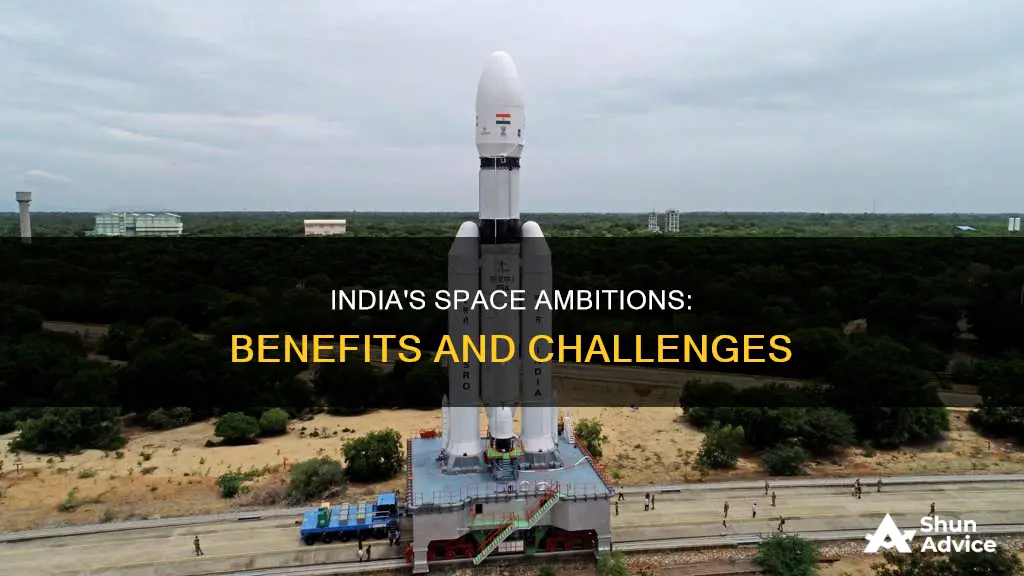
India's space sector is rapidly growing, with increasing opportunities for investment and business ventures. The Indian Space Research Organisation (ISRO) has been central to this growth, promoting private participation and international collaboration in the space sector. ISRO's successful and cost-effective missions, such as the Mars Orbiter Mission, have demonstrated India's capabilities in space technology and boosted its credibility. With a focus on commercialisation, technological development, and exploration missions, India aims to become a major player in the global space market, estimated to be worth $120 billion. The country's growing launch capabilities and competitive launch services make it an attractive option for companies looking to launch their satellites. India's space sector is expected to reach $13 billion by 2025 and capture a larger share of the global space economy by 2030.
| Characteristics | Values |
|---|---|
| Cost-effective | The Mars Orbiter Mission cost $73 million, compared to NASA's MAVEN orbiter, which cost $671 million |
| Self-reliance | India has moved from relying on other countries for space programs to having its own launch vehicle program |
| Nationalism | Prime Minister Narendra Modi has stoked nationalist sentiments, and space exploration is a source of national pride |
| International standing | India is the 6th largest space agency in the world and has signed agreements with other countries for launching foreign satellites |
| Commercial potential | The global satellite market is worth $120 billion, and India hopes to tap into this by offering low-cost launches |
| Scientific research | India has been increasing its budget allocation for scientific research, particularly in space |
| Private sector involvement | The Indian space sector involves over 400 private space companies and startups, with increasing private participation |
| Space exploration | India has successfully launched missions to the Moon and Mars, and is planning a mission to Venus |
What You'll Learn
- India is investing in space to foster self-sufficiency and develop its own technologies
- The country's space program has been decades in the making and is not a result of recent nationalist sentiments
- India's space sector is rapidly growing, with increasing opportunities for investments and businesses
- The country is set to become a hub for the growing satellite launch industry due to its lower costs
- India's space industry is moving towards privatisation to boost its presence and capabilities in space

India is investing in space to foster self-sufficiency and develop its own technologies
India's investment in its space program is driven by a desire to foster self-sufficiency and develop its own technologies. Since gaining independence in 1947, the country has sought to become self-reliant and establish its capabilities in satellite and rocketry technologies. This motivation has guided India's space endeavours for decades, resulting in significant achievements.
The Indian Space Research Organisation (ISRO) has played a pivotal role in this journey. ISRO's focus has been on developing satellite capabilities for mapping, surveying crops, and assessing damage from natural disasters, among other applications. Additionally, satellite communication has been leveraged to bring telemedicine and telecommunication services to remote rural areas, benefiting communities that were previously underserved.
ISRO's achievements include the successful launch of India's first mission to the moon, Chandrayaan-1, in 2008, and the Mars Orbiter Mission, which made India the fourth country to orbit Mars and the first to do so on its first attempt. The organisation has also launched a significant number of foreign satellites, showcasing its reliability and cost-effectiveness.
The growth of India's space sector is driven by increasing commercialisation and international collaborations. The country aims to tap into the lucrative global satellite launch industry, which is dominated by the United States, France, and Russia. By investing in its space program, India seeks to establish itself as a competitive alternative in this market.
The development of new technologies, such as reusable launch vehicles and the Inflatable Aerodynamic Decelerator (IAD), further underscores India's commitment to self-sufficiency and technological advancement. The country's space sector is characterised by the active participation of private companies, startups, and international partnerships, all contributing to a dynamic and evolving space ecosystem.
India's investments in space are aimed at not only fostering self-sufficiency but also enhancing its global presence in the space arena. With a growing launch capability and expanding satellite-based services, India is well-positioned to offer competitive launch services to a diverse range of customers. The country's space sector is expected to play a significant role in India's economic growth, with the potential to capture a larger share of the global space economy by 2030.
Strategies to Optimize Your Investment Portfolio for Maximum Returns
You may want to see also

The country's space program has been decades in the making and is not a result of recent nationalist sentiments
India's space program has been decades in the making and is not a result of recent nationalist sentiments. The country's interest in space exploration dates back to its independence in 1947, when there was a desire to become self-sufficient and develop its own technologies, including satellites and rocketry.
The Indian Space Research Organisation (ISRO), the country's space agency, was established in 1969 and has been working towards enhancing India's capabilities in space technology. Over the years, ISRO has achieved several milestones, including India's first mission to the moon, Chandrayaan-1, in 2008, and the Mars Orbiter Mission in 2014, which made India the fourth country to orbit Mars and the only one to do so on its first attempt.
The success of ISRO cannot be attributed solely to recent nationalist sentiments. Instead, it is the result of decades of investment in space research and development. ISRO's founder, Vikram Sarabhai, emphasised that space exploration was necessary for a developing nation like India to play a meaningful role in the community of nations. This sentiment has guided ISRO's goals, which have been focused on satellite capabilities for mapping, surveying crops, and studying natural disasters, rather than human space exploration.
The organisation's accomplishments are also due to its technocratic nature, where scientists and engineers drive program objectives. This bottom-up approach allows for flexibility and adaptability, as seen in ISRO's ability to put together the Mars Orbiter Mission in just 14 months, demonstrating organisational efficiency.
Additionally, the growth of the global space economy and the increasing demand for satellite-based services have provided further impetus for India's space program. With its low labour costs and efficient launch capabilities, India is well-positioned to offer competitive launch services to customers worldwide. The country aims to increase its share of the global space economy from the current 2-3% to over 10% by 2030.
In conclusion, India's space program is the result of a long-standing interest in space exploration, driven by the desire for self-sufficiency and technological advancement. While nationalist sentiments may play a role in celebrating ISRO's successes, the program's progress is primarily due to decades of dedication, investment, and the emerging opportunities in the space sector.
Portfolio Investments: Developing Countries' Failure
You may want to see also

India's space sector is rapidly growing, with increasing opportunities for investments and businesses
ISRO's Achievements and Growing Capabilities
ISRO has been central to India's space endeavours, launching the country's first satellite, Aryabhata, in 1975. Since then, it has accomplished numerous milestones, including the Mars Orbiter Mission and the Chandrayaan missions to the Moon. Notably, India became the first Asian country and fourth overall to reach Martian orbit with its Mangalyaan Mission, accomplishing this feat on its first attempt. ISRO has also launched a significant number of foreign satellites, showcasing its reliability and cost-effectiveness.
Commercialisation and Private Sector Participation
The Indian space sector is witnessing increasing commercialisation, with ISRO actively promoting private sector involvement. Domestic private companies in the space industry have collectively raised over $245.35 million in funding. The government has introduced favourable policies, such as the Space Policy 2023, recognising the critical role of the private sector in the space economy's value chain. This has encouraged startups and technology innovators to emerge, with over 400 private space companies now operating in India, ranking the country fifth globally in the number of space companies.
International Collaborations
ISRO has fostered international collaborations by signing agreements and Memorandums of Understanding (MoUs) with various countries and organisations for joint missions and technology transfers. For instance, Microsoft has signed an MoU with ISRO to support space tech startups using cloud-based tools and AI-powered platforms.
Emerging Trends in Space Exploration
India is focused on expanding its space exploration missions, with the Gaganyaan mission, India's first crewed flight into space, initially planned for 2023, and the Chandrayaan-3 lunar exploration mission, scheduled for 2023. Additionally, ISRO is developing new technologies, such as reusable launch vehicles and the Inflatable Aerodynamic Decelerator (IAD). The expansion of satellite-based services, including remote sensing, satellite-based navigation, and meteorology, is also underway.
In conclusion, India's space sector is experiencing rapid growth, driven by ISRO's advancements, increasing commercialisation, international collaborations, and emerging trends in space exploration. With continued government support and private sector participation, India is poised to become a significant player in the global space market, presenting numerous investment and business opportunities.
Fidelity's Investment Management: Is It Right for You?
You may want to see also

The country is set to become a hub for the growing satellite launch industry due to its lower costs
India is set to become a hub for the growing satellite launch industry due to its lower costs. The country has been investing in space exploration since its first mission to the moon, Chandrayaan-1, successfully launched in 2008. Since then, the Indian Space Research Organisation (ISRO) has made significant strides, including launching a record-breaking 104 satellites into orbit in 2017. This feat showcased ISRO's engineering capabilities and its ability to offer relatively low-cost satellite launches compared to other countries.
The Indian government has been boosting the budget for its space program, and ISRO has been planning ambitious missions, such as returning to the moon and exploring Mars. The organisation's success is not solely due to recent nationalist sentiments but rather a result of decades of development and a strong focus on satellite technology. ISRO's efficient organisation and India's lower labour costs contribute to the country's ability to offer competitive prices for satellite launches.
The Indian space sector is also witnessing the emergence of startups and private companies, further driving innovation and cost reduction. The government has encouraged private participation, and the number of startups in the space sector is growing. These companies are developing cost-effective space programs and new designs, disrupting the industry and creating new opportunities. The collaboration between the public and private sectors is expected to further enhance India's position in the global space economy.
The country's space sector is valued at $9.6 billion in 2020 and is projected to reach $13 billion by 2025. With its low-cost satellite launches and growing private sector involvement, India is well-positioned to capture a larger share of the global space economy in the coming years. The country's advancements in space technology and its competitive pricing make it an attractive option for satellite launches, solidifying its potential to become a hub for the satellite launch industry.
Understanding Your Investment Portfolio Report: A Guide
You may want to see also

India's space industry is moving towards privatisation to boost its presence and capabilities in space
India's space industry is undergoing a significant transformation, with privatisation playing a pivotal role in boosting the country's presence and capabilities in space. This shift is driven by the recognition that privatisation will be key to enhancing India's position in the global space arena. Here are some key aspects of this evolving narrative:
Historical Context
India's space programme has a long history, dating back to the early post-Independence era. From the outset, the focus was on building self-reliance and enabling developmental applications, such as remote sensing, cartography, and geo-spatial resource mapping. Over the years, ISRO, the Indian Space Research Organisation, has played a pivotal role in this journey, with its formation in 1969 marking a significant milestone.
Recent Developments
In recent times, there has been a conscious push towards privatisation within the Indian spacetech sector. The Indian government's decision to open up the space sector to private players is a significant development. This move is expected to provide the boost ISRO needs to expand its horizons and emulate the success of NASA, which thrives due to its robust engagement with the private sector. The establishment of New Space India Limited (NSIL) and the Indian National Space Promotion and Authorisation Centre (IN-SPACe) are concrete steps in this direction.
Advantages of Privatisation
Privatisation brings several advantages to the table. Firstly, it encourages active private sector involvement in crucial aspects of research, manufacturing, and fabrication of rockets and satellites, fostering a vibrant ecosystem of innovation. Secondly, it enables ISRO to focus more on its core strengths, such as research and development, exploring new technologies, and planning new space missions. Additionally, privatisation can attract more funding and resources, allowing for increased satellite launches and more efficient utilisation of ISRO's capabilities.
Global Standing
ISRO has already made significant strides in the global space arena. It is recognised for its cost-effective satellites and the successful launch of the Mars Orbiter Mission, making India the first nation to reach Martian orbit on its first attempt. With over 400 private space companies, India ranks fifth globally in the number of space companies. Additionally, the Indian space sector is projected to reach a value of $13 billion by 2025, aiming to capture a larger share of the global space economy by 2030.
Challenges and Opportunities
While privatisation offers numerous benefits, there are also challenges and opportunities to consider. One potential challenge lies in the structural weaknesses and capability constraints within the Indian private sector. Additionally, there are strategic concerns, especially regarding the dual civilian and military applications of space technologies. However, the opportunities presented by emerging areas such as space tourism, asteroid mining, and the development of new propulsion technologies offer enormous scope for growth and innovation.
In conclusion, India's space industry is indeed moving towards privatisation to boost its presence and capabilities in space. This shift is expected to create a more dynamic, innovative, and competitive environment, positioning India as a key player in the global space arena.
Best Places to Buy Investment Portfolios: A Comprehensive Guide
You may want to see also
Frequently asked questions
India has argued that spending on science and technology leads to social development. The country is aiming to encourage other developing nations to use their space program for launches, rather than relying on Western nations.
India's space sector is recognised for building cost-effective satellites. The country is also looking to tap into the lucrative satellite launch industry, which is worth billions of dollars.
India's space program has been described as the sixth largest in the world. The country was the fourth to put a spacecraft in orbit around Mars and the first to do so on its first attempt.







